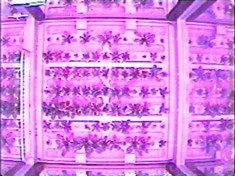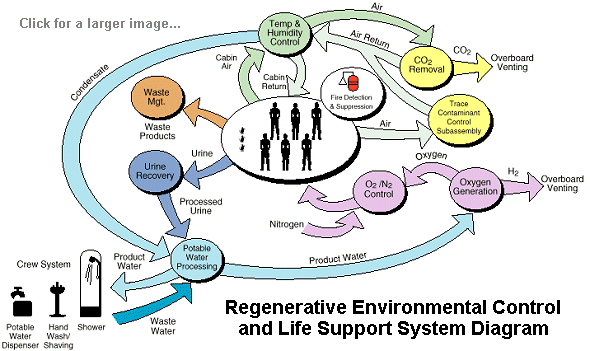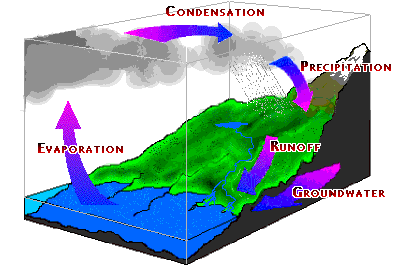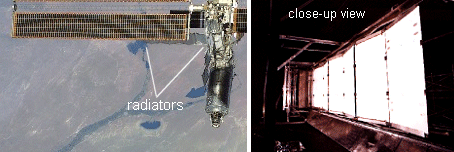
NASA --
bioregenerative
life support
Plants are essential companion
lifeforms for long-term space
missions, where Human habitats
must mimic the cycles of life
on Earth to generate and recycle
food, oxygen, and water.
Open Regenerative Systems
Recycling on the Space Station - Life support systems on the International Space Station supply oxygen and remove carbon dioxide from the station atmosphere. They also prevent gases like ammonia and acetone, which people emit in small amounts, from building up to dangerous levels. Indeed, vaporous chemicals from science experiments are a potential hazard since they can combine in expected ways with other elements in the air supply.

NASA (Recycling on the International Space Station -- larger image.)
Initially, Space Station personnel breathed oxygen from "perchlorate candles," which produce oxygen using chemical reactions inside a metal canister. Later, the arrival of new equipment was used to produce oxygen using "electrolysis," which uses electricity from Solar panels to split water molecules into hydrogen gas and oxygen gas. Currently, carbon dioxide is removed from the air by a machine using a material called "zeolite" as a molecular sieve, while hydrogen that is generated from this process is vented into space. Eventually, however, a machine will be used to combines the hydrogen with excess carbon dioxide from the air in a chemical reaction to produce water and methane. The water produced would partially replace the water used to make oxygen, while the methane would be vented to space. In the event of breakdowns, however, the ISS will maintain redundant supplies of oxygen gas for the safety of the crew.
In Humans, methane and carbon dioxide are produced in the intestines, and ammonia is created by the breakdown of urea in sweat. Humans also emit acetone, methyl alcohol, and carbon monoxide, as the byproducts of metabolism through urination and breathing. Currently, activated charcoal filters are the primary method by which these chemicals are removed from the air.
In the short term, such chemical-mechanical systems are much more compact, less labor intensive, and more reliable than a plant-based system, at present. Such systems, however, would be too expensive for the long-term habitation of Humans in space (see "breathing easy on the space station" from NASA).
Water Recycling - Water recycling also implies purification. Artificial or natural filters remove particles and debris then other other organic and inorganic impurities from waste water. In artificial systems, "catalytic oxidation" is used to remove volatile organic compounds and to kills bacteria and viruses. Waste waters from fuel cells, urine, oral hygiene, bathing, hand washing, and humidity in the air must be recycled. Otherwise, around 10,000 pounds of water per year would have to be lifted from Earth (or farther places) per year of water from Earth for each Human personnel of a space habitat.

NASA (Water cycle on Earth
more)
Closed Bioregenerative Systems
Mimicking Biocycles - On Earth, plants, algae, cyanobacteria, and phytoplankton all split water molecules as part of photosynthesis. That biochemical process converts sunlight, carbon dioxide and water into sugars for food. The hydrogen generated is used for making sugars and other carbohydrates, while the oxygen is released into the atmosphere.
Plants in Microgravity - In an orbiting greenhouse, freely-falling plants lack the constant downward pull of gravity, and so water spreads out too evenly in the soil-like material around their roots, making it more difficult for air and water to reach the roots. On solution has been to use soil with granules of a certain size. If soil grains are too big, the roots won't get enough water; if they're too small, not enough air. In addition, there may be insufficient air circulation in an orbiting habitat so that plants can suffocate on their own "exhaled" oxygen with the use of fans to keep the air moving. (See "leafy green astronauts" and gravitational biology from NASA).

NASA
Testing plants for
orbital farms
(more)
Other Environmental Systems
Thermal Control System - On Earth, environmental heat is transferred in the air primarily by conduction (collisions between individual air molecules) and convection (the circulation or bulk motion of air). In the airless environs of space, however, the temperature of the orbiting Space Station's Sun-facing side would soar to 250 degrees F (121 C) but plunge to minus 250 degrees F (-157 C) on the dark side without thermal controls. To keep the temperature more even, the station is insulated to make it relatively impermeable to Solar thermal radiation, keeping heat in for warmth and to keeping it out for cooling.
The Station is covered with a highly-reflective blanket called Multi-Layer Insulation (or MLI) made of Mylar and dacron. Mesh sheets of Mylar are aluminized so that solar thermal radiation can't get through it, like the aluminized Mylar blankets used to wrap people who have been exposed to cold or trauma and popular among hunters and campers. The sheets of silvery-looking Mylar used are fragile, being only 0.3 mil (3/10000 of an inch) thick, and so are protected by a heavier layer of copper-colored, Kapton material. Layers of dacron fabric are used to keep the Mylar sheets separated, which prevents heat from being conducted between layers.

NASA (Radiators used on the International Space Station).
In fact, the Station is so well insulated that it must shed waste heat generated by on-board equipment. Waste heat is removed both cold plates and heat exchangers, both of which are cooled by a circulating water loop. Air and water heat exchangers cool and dehumidify the Station's internal atmosphere, while high heat generators are attached to custom-built cold plates. Cold water -- circulated by a 17,000-rpm impeller the size of a quarter -- courses through these heat-exchanging devices to cool Station equipment, by sending thermal energy to outside radiators to radiate that heat into space (see "staying cool on the ISS" from NASA.
Space Station Life Support (Marshall Space Center)
Advanced Life Support (Johnson Space Center)
Advanced Life Support and Gravitational Biology (Kennedy Space Center)